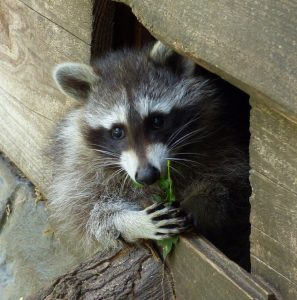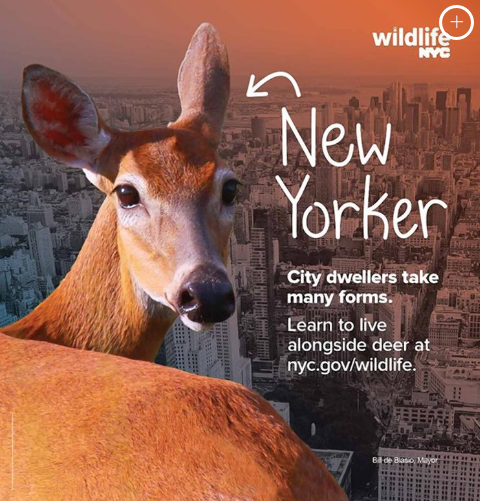The other day my daughter was up during the wee hours doing homework in the kitchen and in walked one of our cats…or so she thought. When she looked up she found herself face to face with a small but plump raccoon, also a juvenile. They looked at each other, equally surprised, and ran in opposite directions.
This clever little fellow had used our dog door to come in for a tasty meal. (Solving the recent mystery of a suddenly empty cat food bowl and strangely muddy water dish.)
But while my daughter was jarred by this unexpected encounter, there was no cause for alarm. He was just one of many animals that live in the wooded area around our home — known to him as his home. He meant us no harm. The solution was not a panicked call to an animal removal company to have him — or some other totally innocent raccoon — trapped and killed.
For wildlife issues such as these, the most effective solution is also the humane one. One that usually involves understanding, patience, persistence and ingenuity. In my case, however, the answer was quite simple: lock the dog door at night.
One can’t underestimate the appeal of a cheap and easy meal. This is true for human (Hello, world full of fast food chains!) as well as non-human animals. So solutions often involve removing, or deterring from, the inviting meals inadvertently put out.
Living in harmony with nature requires understanding and recognition that we share the world with other animals also just trying to survive.
I love that Ann Arbor is a community that cherishes nature. We are so lucky to have 159 beautiful parks and nature areas interwoven throughout the city. But so much natural space within a densely populated city brings challenges.
Wildlife are an integral part of the natural landscape. In the Ann Arbor area, one may come across turtles, frogs, snakes, hawks, blue heron, deer, geese, ducks, swans, raccoons, chipmunks, rabbits, opossums, foxes, coyotes, and even bald eagles.
For some of us, this is a source of wonder and awe. But for others, it can cause frustration and fear. Particularly when there is a dearth of knowledge of wildlife behavior and how to handle conflicts that may arise.
This is not unique to Ann Arbor, however. The human population explosion, urban sprawl and drastic decline in rural and forested areas throughout the U.S. have tasked many communities similarly. We are living in increasingly closer proximity with wild animals. And with so few people having any country-life experience, it can be too close for comfort.
Many animals live right underneath our noses without us ever knowing it. But as they adapt to our changing world, they find new ways to survive. Unfortunately they can’t see property lines, don’t know they are eating prized plants and don’t realize they are invading our homes. They are simply searching for what we all need – food and a safe, warm place to sleep and have our babies.
Some friends recently sent me pictures from New York City – Manhattan no less.
It’s part of a big educational campaign. It’s on buses, subways, and billboards. Public officials want their residents to know they are sharing their community with wildlife. They want to improve awareness and thereby create realistic expectations and greater tolerance.
So the question is what has nature-loving Ann Arbor done to help residents understand and address the challenges of having wildlife in our parks and yards?
The answer: Nothing.
I am not just harping on our ill-conceived approach to deer. I am talking about public education related to all backyard wildlife that are often labeled as “nuisances” and that some unrealistically think can be eliminated.
We can try to shoot them, trap them or poison them away. But those are not just inhumane, morally questionable acts that fly in the face of our normally peace-promoting and compassionate community, they are wasteful quick fixes that fix little. Because the fact is, love them or hate them, they are here to stay.
Obviously we at HSHV love animals. (And we mean all animals. Not just the ones that sleep in our beds and steal our cookies.) We have a 121-year history of protecting and promoting respect for animal life. Throughout our history our focus has been any individual or group of animals under assault. The “underdogs,” if you will.
For the last 50 years or so, we’ve provided 24/7 emergency services for sick and injured wildlife and more recently added Humane Wildlife Services aimed at helping homeowners address conflicts with wildlife.
As such, I feel confident in saying that most community members care about wildlife. I see their compassion every day. They do not want to see needless suffering or killing. Almost always hoping for the same thing…that we can save them.
But residents need help knowing their wild neighbors and what to do when it gets personal, and feelings of fear and frustration take over.
Because while human/wildlife conflict is inevitable, it is also solvable!
Let’s take the next step in loving nature by investing in improving our community’s understanding of the wildlife that lives within and work towards the peaceful co-existence that we all deserve.




